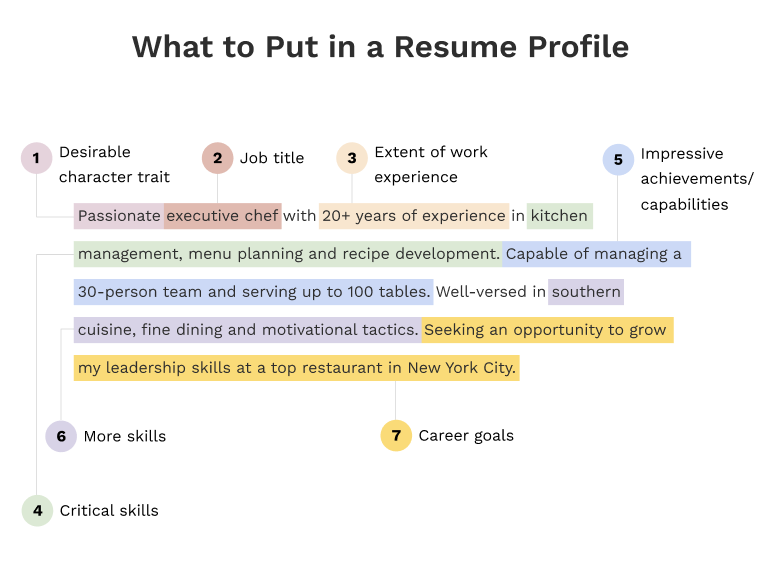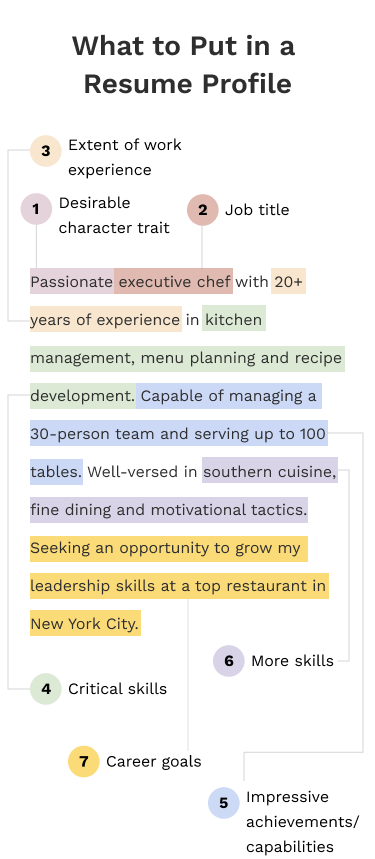Resume profiles summarize your skills, experience, and qualifications in a single paragraph. While profiles come in a few different forms, they have one common goal: to grab the hiring manager’s attention.
Before you write your own profile, review some real-world examples to stay on track. We’ve collected profiles from dozens of industries to help you craft the perfect opener.
Get help writing your resume profile quickly and easily. Use our AI Resume Summary Generator to write the perfect profile in minutes. The tool will generate a summary tailored to your resume, which you can customize as needed.
What Is a Resume Profile?
Resume profiles summarize a candidate’s top qualifications, skills, and achievements in three or four sentences. They are typically found near the top of the resume to set the stage for what’s to come.
The goal of a resume profile is twofold: catch an employer’s attention and convince them you’re the right person for the job. Hiring managers often have little time to dedicate to reading each resume and may have to read through hundreds of resumes for each role. It’s important that your resume profile makes an immediate and lasting impression.
How to Write a Resume Profile
A well-written resume profile will make the case that you are the best fit for the position. How do you do that? This example demonstrates the right approach:
Check out this example of a resume profile that hits all the right notes:
This profile example is a great addition to the applicant’s resume. Here are a few ways it makes the resume more appealing:
- This example mentions up front how long the candidate has been working in the industry, making it easy for the employer to see their level of experience.
- It also includes many skills listed in the job description; the use of these keywords helps make the case that the candidate’s skills are a match for the role.
- This profile cites two impressive achievements using numbers to drive home the impact of the candidate’s work.
- The candidate makes their career goals clear and explains how those goals benefit the employer.
Now, there are three different types of resume profiles to choose from, each designed to achieve the same goal but tailored to suit different candidates.
Resume Profile Examples—3 Types
Resume profiles are known by various names, including resume objectives and professional summaries. Each serves a different purpose and requires a distinct writing style and content strategy. Let’s dive in.
Objective statement
An objective-style resume profile focuses its attention on a candidate’s goals and explains why they want the job. Resume objective statements are often used for particular career situations that the candidate may want to explain.
Common reasons to use an objective include having little to no experience, changing careers, seeking a promotion, and returning to the workforce after a long absence.
If you’re seeking your first job, for example, discussing your future goals is more productive than focusing on a lack of experience.
Here’s a great example:
Results-oriented financial analyst with 10+ years of experience at Mabel Financial seeking to transition into an account manager role in the same department. Proven ability to use business analytics to communicate, persuade, and build relationships. Will work to leverage business relationships with current and prospective clients to exceed the company’s sales targets.
Professional summary
A professional summary is the gold standard of resume profiles. Any job seeker could write an engaging, three- or four-sentence paragraph that highlights the skills, accomplishments, and experience that make them a perfect match for the role.
Concise summaries packed with action words and data-driven achievements will pique an employer’s interest.
Here’s a great example:
Award-winning copywriter with strong product sense and seven years of experience helping small businesses increase sales through savvy branding, social media campaigns, and compelling ad copy. Recently wrote copy for a series of ads for a nonprofit raising money to fight breast cancer, ultimately bringing in $500K—a 20% increase over the previous year. Excellent attention to detail and ability to collaborate with designers.
Bulleted list
Our final resume profile example is a bullet-point list. Instead of laying out your career arc in a paragraph, the bulleted list, sometimes called a qualifications summary, uses bullets to make the content more readable.
An advantage of the list style is that it puts a greater emphasis on quantifiable results and accomplishments. This style is frequently used on functional resumes, one of the top resume formats.
Here’s a great example:
- Created more than 10 advanced applications with complicated functional requirements.
- Oversaw programming bootcamp, helping 12 new programmers create apps that led to full-time jobs.
- Awarded the University of Illinois’ ACM fellowship in 2018.
If you’d like to see how these resume profiles look on the page, check out our library of resume examples or resume templates.
Now that you know the three types of resume profiles, let’s get even more specific with some examples by job.
Pro tip:
We’ve covered all three kinds of resume profiles, but there is one more alternative. If you want to save space on your resume and stick with a catchy and concise introduction to your career, try a resume headline. Resume headlines are just a single sentence long and focus on quickly outlining your career title, a few skills, and experience-focused keywords.
Resume Profile Examples for 30+ Jobs
Actor
Summary of Qualifications
- Skilled actor with over five years’ experience taking on diverse roles in commercial productions.
- Starred in a film that won the “Best Short Movie” award at Columbia College Chicago.
- Performed as a voice-over artist for an RPG released by Unity Games.
See a full actor resume.
Administrative assistant
Detail-oriented administrative assistant with 10+ years of experience handling scheduling, administrative support, and organization for top executives in the entertainment industry. Proven ability to multitask, plan events, and write ingoing and outgoing messages in a high-pressure environment. Proficient in all major email platforms, spreadsheet software, and fax machines. Highly independent and capable of working remotely.
See a full administrative assistant resume.
Attorney
Hard-working attorney with more than five years of experience representing manufacturing industry employees. Proven ability to carry case files from concept to trial and sometimes appeal. At JJ Associates, reviewed 10% more pleadings than the company average. Brings strong attention to detail and superior client communication skills essential for providing ethical and practical legal advice at Bradford & Associates.
See a full attorney resume.
Auto mechanic
ASE-certified auto mechanic with 20 years of experience working in a hectic environment. Provided routine maintenance—including tire rotations, oil changes, and filter replacements—to 20+ customers per day. Engaged in friendly and professional communication with customers and other mechanics. Knowledgeable in both domestic and foreign vehicles.
See a full auto mechanic resume.
Banker
Dedicated banker with more than three years serving customers at JPMorgan Chase. Exceptional time management and organizational skills with in-depth experience in spreadsheets and money handling. Skilled at memorizing personal details to give each customer a personalized experience. Proven ability to collaborate with co-workers and deliver a seamless customer service experience.
See a full banker resume.
Carpenter
Determined carpenter with more than three years of experience serving Sun City Builders in high-profile projects seeking a full-time position with the company. Extensive knowledge of cabinet making, furniture building, and safety procedures. Interested in leveraging advanced communication skills and company relationships to improve collaboration across departments and eventually take on a leadership role.
See a full carpenter resume.
Claims adjuster
Passionate insurance professional with a strong track record of investigating auto insurance claims on behalf of insurance companies. Skilled at reading and evaluating police reports, video footage, and previous insurance claims. In a previous role, annually discovered 120 more unwarranted claims than the team average. Possesses an excellent work ethic and focus.
See a full claims adjuster resume.
Cook
Creative and passionate cook with over six years of experience in high-paced kitchen environments. Specialized in crafting diverse menus with a focus on fresh, local ingredients. Strong skills in meal preparation, inventory management, and kitchen hygiene. Committed to providing high-quality, delicious, and aesthetically pleasing dishes. Eager to bring culinary expertise and innovation to a dynamic new restaurant.
See a full cook resume.
Customer service
Highly motivated and results-oriented customer service representative with three years of experience dedicated to enhancing customer satisfaction and fostering loyalty. Seeking to join [company name] to utilize exceptional communication and problem-solving skills to exceed customer expectations and contribute to the company’s reputation for outstanding service. Aiming to streamline processes, reduce response times, and implement innovative solutions to improve overall customer experience and drive business growth.
See a full customer service resume.
Dancer
Outgoing dance instructor with advanced experience in ballet, jazz, hip hop, and tap dance. Demonstrated ability to plan curriculum for different styles and skill levels. Taught a class of 20+ students at NYC Dance for more than five years. Highly rated by students in retrospective surveys.
See a full dancer resume.
Dialysis technician
CHT-certified dialysis technician seeking to leverage five years of experience making life better for patients with kidney disease into a role at Alba Hospital. Well-versed in treatment modalities for end-stage renal disease. Knowledgeable in HIPAA regulations and aseptic techniques. CPR certified.
See a full dialysis technician resume.
Doctor
Medical doctor with 10+ years of experience at a highly-regarded regional medical center. Known for conducting in-depth research into patient medical histories and providing holistic treatment plans. Maintained a five-star Healthgrades score and received a 90% score for helping patients achieve goals based on follow-up surveys. Takes great pride in treating the team respectfully.
See a full doctor resume.
Electrical engineer
Accomplished electrical engineer with extensive experience delivering complicated designs within budget and on schedule. Certified as a licensed professional engineer (P.E.) and highly proficient with Revit and AutoCAD. In-depth understanding of single-line diagrams, load calculations, system layout, and specifications. Proven ability to collaborate with a wide variety of departments and personalities.
See a full electrical engineer resume.
Farmer
Dedicated farm manager with extensive experience in equipment maintenance, irrigation, and contract negotiation. Managed our 100-acre family farmland for more than 15 years. Capable of handling repairs of all major equipment. Skilled in planting, harvesting, and cattle ranching.
See a full farmer resume.
Front desk receptionist
Highly organized front desk receptionist with six years of experience at Bryce Cosmetics seeking a position in the tech industry. Proven ability to manage dozens of ingoing and outgoing messages per day while maintaining schedules and privacy compliance. Commended by co-workers for having a positive attitude and approachable demeanor. Up to date on the latest administrative software.
See a full front desk receptionist resume.
Hotel manager
Seasoned hotel manager with a consistent track record of delivering exceptional cleanliness, organization, and customer service for 10+ years. Received the Hotel Inn’s “Manager of the Month” award twice in the last two years. Capable of partnering with the finance team to implement and monitor the hotel’s operational budget. Improved customer satisfaction survey results by 20% in previous role.
See a full hotel manager resume.
HR assistant
Highly organized human resources assistant with extensive experience working with human resource files and documentation. Proven ability to maintain the integrity and confidentiality of HR records. Skilled at using payroll management software to assist in processing, fixing errors, and sending checks. Seeking a position as an HR assistant at a Fortune 500 company.
See a full HR assistant resume.
HR intern
Summary of Qualifications
- Assisted the student newspaper editor in settling disputes between writers.
- Helped raise $10K for the Boys & Girls Clubs of America.
- Recruited seven students for the Photography Club.
See a full HR intern resume.
Information technology
Highly skilled and results-driven IT professional with over 10 years of experience in designing, implementing, and managing IT infrastructure and systems. Adept at solving complex technical problems and delivering innovative solutions that enhance operational efficiency. Proven expertise in network administration, cybersecurity, cloud computing, and software development.
See a full information technology resume.
Legal intern
Summary of Qualifications
- Handled filing, note-taking, and data entry for a law professor for three semesters.
- Completed an in-depth legal writing course at a top U.S. law school.
- Named Debate Champion at Georgetown University in fall 2019.
See a full legal intern resume.
Medical assistant
Highly motivated medical assistant with over five years of experience providing patients with excellent care in an outpatient setting. Empathetic and driven with a proven track record of monitoring 30+ patients per day. Skilled at checking vital signs, conducting pre-certifications, and ordering labs, medical supplies, and X-rays. Knowledgeable in HIPAA and OSHA compliance.
See a full medical assistant resume.
Nanny
Nonsmoking high school graduate who is aiming to leverage an excellent academic track record and previous babysitting experience to work as a nanny. Served as babysitter for five families with children ages 2-13. Received glowing recommendations from all clients. Certified in CPR and first aid.
See a full nanny resume.
Officer manager
Efficient and detail-oriented office manager with over four years of experience managing office operations at a mid-sized firm. Proficient in a range of office software, including scheduling and payroll systems. Known for excellent organizational skills and the ability to oversee multiple tasks simultaneously. Proven record in improving office workflows and fostering a positive work environment.
See a full office manager resume.
Paramedic
Compassionate and energetic paramedic with extensive experience providing exceptional emergency medical assistance throughout the Chicago region. Seeking to bring collaboration and problem-solving skills to Cook Medical Center. Capable of 12-hour shifts and running eight to 10 calls per day. Received a commendation for response time and prep work. Skilled in documentation.
See a full paramedic resume.
Personal trainer
Dynamic personal trainer with three years of experience in fitness coaching and client wellness. Specialized in designing personalized fitness programs that cater to individual client goals, ranging from weight loss to muscle building. Certified in various fitness methodologies and nutrition planning. Known for inspiring clients with enthusiastic support and a focus on achieving measurable results.
See a full personal trainer resume.
Pharmacist
Highly organized pharmacist with extensive experience in a retail setting. Reviewed and filled prescriptions with 100% accuracy while maintaining a safe and professional work environment. Trained and supervised 12 pharmacy technicians with a 95% retention rate over five years. Skilled in customer service and medical counseling.
See a full pharmacist resume.
Pilot
Commercial airline pilot with 5,000+ flight hours and certification in multiple aircraft types. Maintained a perfect safety record while completing 500+ international flights. Expertise in weather navigation, emergency procedures, and crew resource management. Previous experience as a flight instructor with 50+ students trained.
See a full pilot resume.
Programmer
Innovative programmer with over six years of experience building scalable web applications. Expertise in JavaScript, Python, and cloud technologies. Led the development of three major products that increased company revenue by 40%. Strong communicator who excels at translating technical concepts for nontechnical stakeholders.
See a full programmer resume.
Property manager
Dedicated property manager with over five years of experience in residential and commercial property management. Expertise in tenant relations, lease administration, and property maintenance. Strong financial acumen in managing budgets and reducing operational costs. Excellent communicator with a proven ability to negotiate contracts and resolve conflicts. Committed to delivering top-notch service to property owners and tenants.
See a full property manager resume.
Recruiting coordinator
Dynamic and detail-oriented recruiting coordinator with five years of experience in supporting recruitment processes and enhancing talent acquisition strategies. Proficient in coordinating high-volume recruitment activities, including candidate sourcing, interview scheduling, and onboarding. Adept at building strong relationships with hiring managers and candidates, ensuring a positive and efficient recruitment experience.
See a full recruiting coordinator resume.
Registered nurse
Dependable and compassionate registered nurse with more than five years of professional experience caring for elderly and disabled adults. Provided outstanding client care for 50+ differently abled patients in a rehabilitation center. Maintained a 90% patient satisfaction rate with personable, friendly, and sympathetic care. Knowledgeable in HIPAA and OSHA compliance. Helped onboard a dozen nursing assistants in 2022.
See a full registered nurse resume.
SEO analyst
Creative and collaborative SEO analyst with over five years of experience helping marketing teams increase ranking and conversions. Proven ability to analyze SEO performance and build content that works for bots and general audiences, while overseeing multiple projects simultaneously. In a previous role, worked with design, development, and content teams to boost organic SEO impressions by 60%. Eager to leverage skills and accomplishments into a leadership role at Brigham Marketing.
See a full SEO analyst resume.
Social media manager
Results-driven social media manager with four years of experience growing brand presence across platforms. Increased engagement by 85% and followers by 50K in previous role. Skilled in content creation, analytics, and crisis management. Experience with paid advertising and influencer partnerships.
See a full social media manager resume.
Teacher
Passionate high school teacher with more than a decade of experience working in public schools. Skilled in lesson planning, time management, and active listening with a special focus on ethics and critical thinking. Proactively attends conferences and workshops to further professional development. Demonstrated ability to maintain safe and supportive learning environments. Won an excellence in teaching award in Illinois.
See a full teacher resume.
Tutor
Energetic and dependable retiree with many years of experience as an after-school teacher seeking a tutor position at the Bay Learning Center. Knowledgeable in a broad range of content areas. Excellent communicator with strong ability to increase student engagement and participation. Skilled at developing individualized lesson plans based on a pupil’s needs and goals.
See a full tutor resume.
Resume Profile FAQ
Last Updated: June 25, 2025
Here are six things to include in your resume profile:
- Years worked in the profession
- Relevant skills and experiences
- One or two personality traits
- Keywords found in the job listing
- Achievements backed by quantifiable metrics
- Career goals
A good resume profile summary is a two- to three-sentence encapsulation of the skills, accomplishments, and experiences that make you a good match for a job. Typically found at the top of a resume, a well-written summary will be easy to scan and entice the hiring manager to call you back for an interview.
When you’re finished writing your resume, make sure to create a matching cover letter. Our cover letter examples will help you write a more compelling letter, and our cover letter templates showcase a range of design styles.
Write your job profile after you’ve finished creating a resume outline. Then, comb through your work experience and skills sections for the accomplishments and strengths you’d like to highlight in your profile. When finished, pull up the job description, underlining any keywords you don’t already have on your resume.
With these resources lined up, you should be able to write three or four concise, compelling sentences to summarize your career. Make sure you use quantifiable metrics to illustrate your results whenever possible and touch on the keywords and qualifications in the job description.
As a final step, make sure your resume, including the profile section, is properly formatted.
A resume profile is a short summary of skills and qualifications that goes at the top of your resume. It’s no longer than three or four sentences and should convince the employer you’re the right fit for the role. A professional summary is a type of resume profile that focuses on summarizing a candidate’s top accomplishments.
If you’re writing a resume profile with no experience, you should make it an objective statement. An objective statement is future-oriented, explaining why you’re interested in the position and how you can help the company.
Since you have no professional experience, you should focus on other ways you’ve developed your skills, like volunteer work, school projects, and extracurricular activities. You may be surprised to find that you have more qualifications than you thought.
Was this information about Resume Profile Examples + How To Write A Strong One helpful? Let us know!
Don is a Certified Professional Resume Writer (CPRW) with more than 10 years’ experience creating digital content, including four years helping job seekers develop their careers. He holds an M.S. in Journalism from Northwestern University.
More resources

63% Expect AI’s Role in Compensation to Grow Significantly in the Next 5 Years
Resume Now s latest report examines how workers are responding...

How to Include Research Skills on a Resume: 40+ Examples
Check out our guide to understand what research skills are and...

How To Write a CV: The Ultimate Guide for 2025
Here is a complete and comprehensive guide to writing a CV ev...
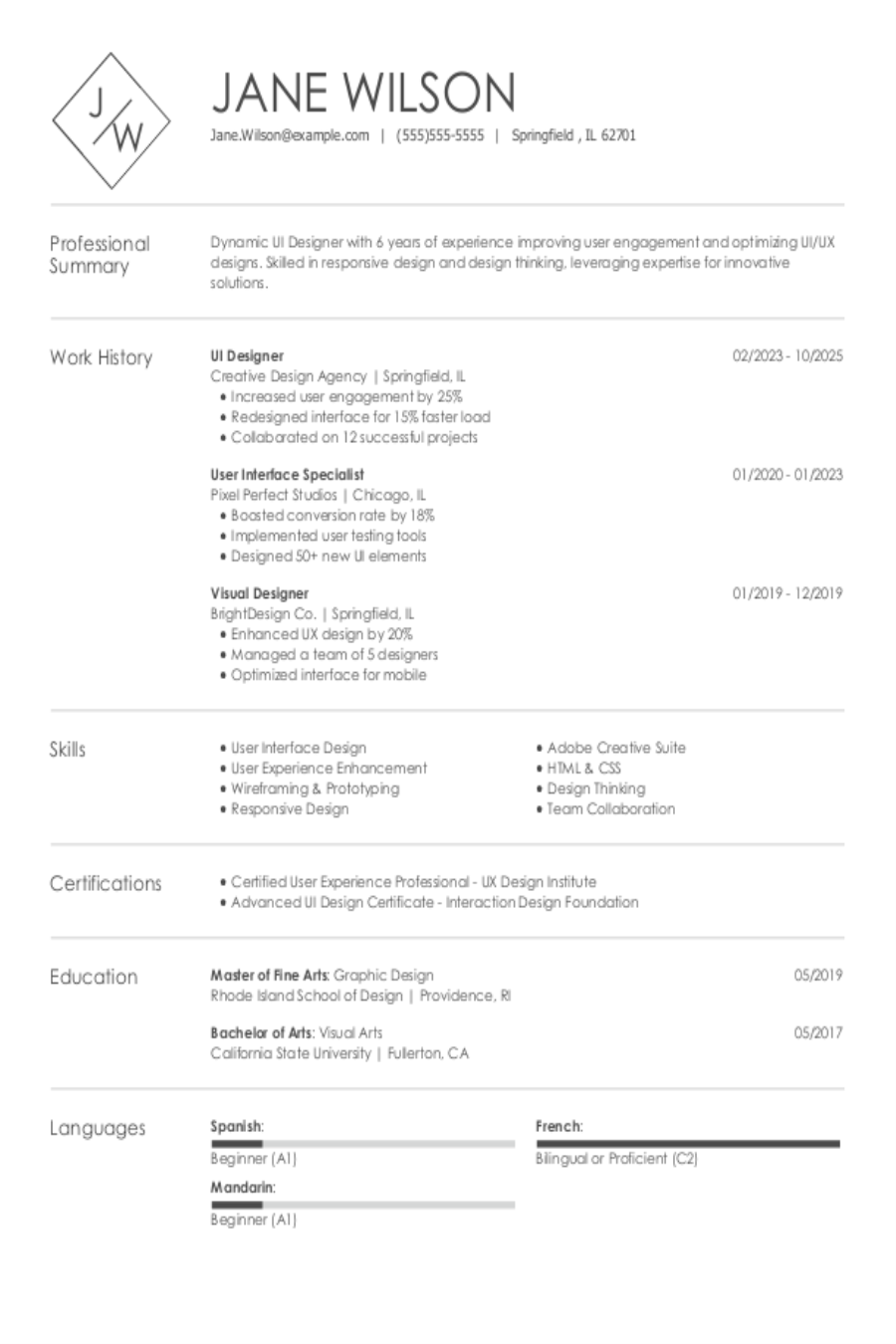
UI Designer Resume: Examples, Templates and Tips
Build & download your UI Designer resume in a few simple steps...
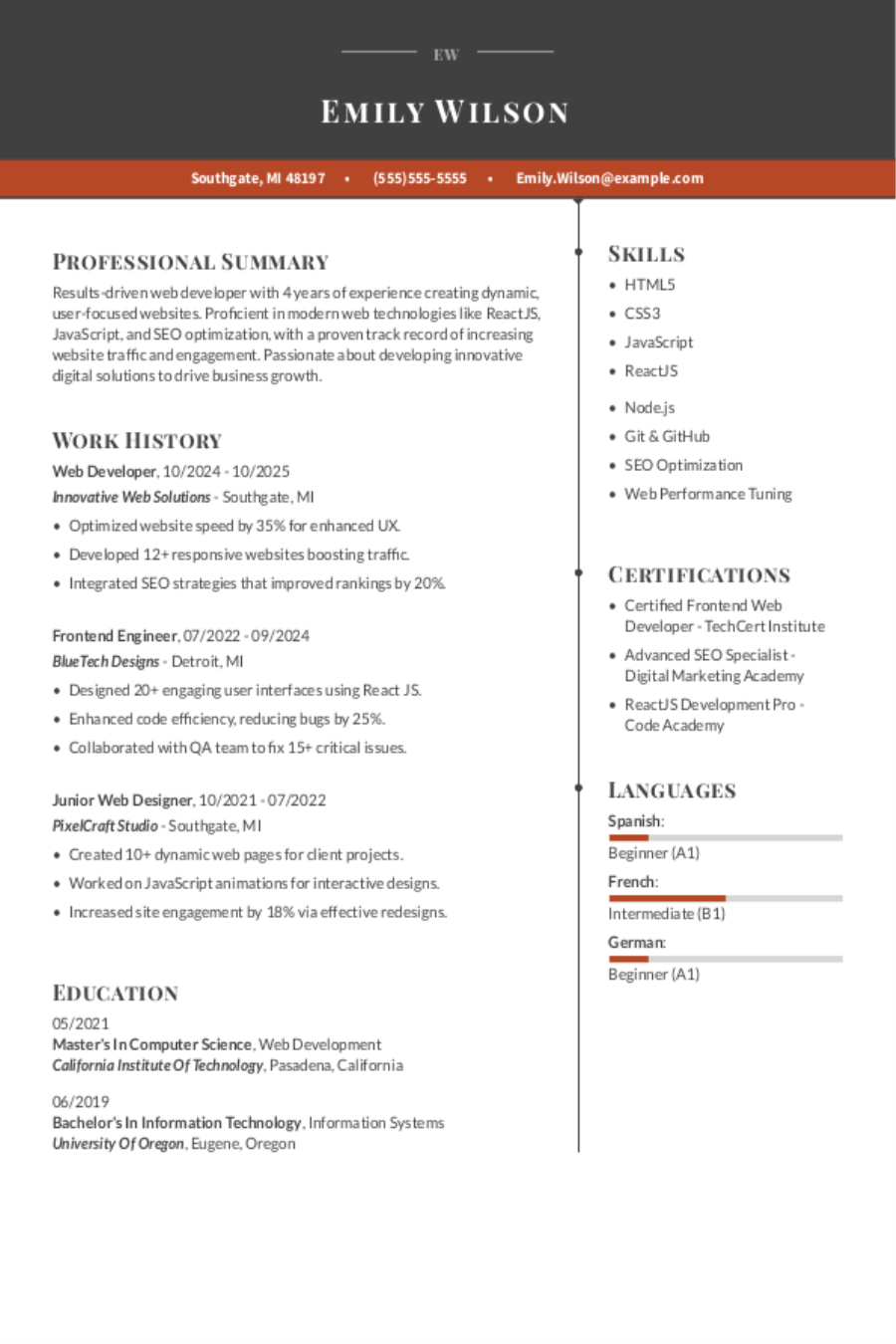
Web Developer Resume: Examples, Templates & Tips for 2025
Build & download your Web Developer resume in a few simple ste...
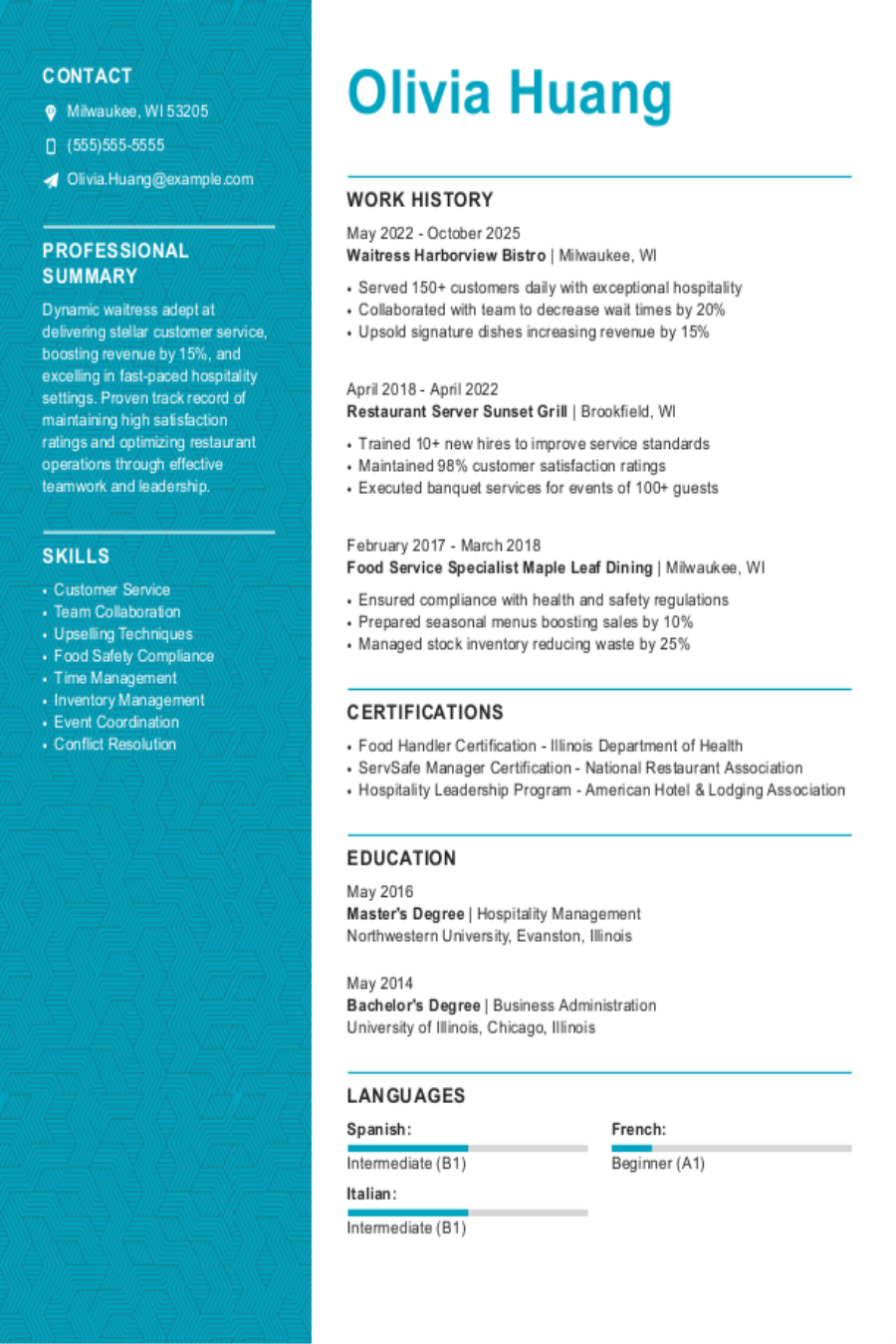
Waitress Resume: Examples, Templates and Tips
Build & download your Waitress resume in a few simple steps. B...

